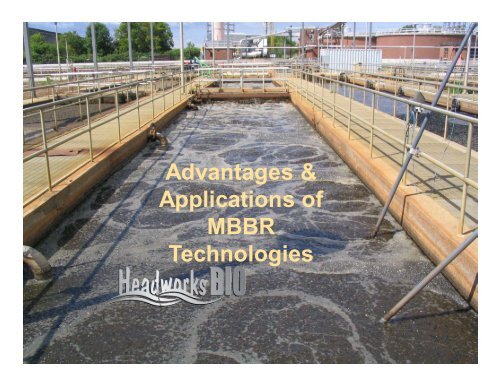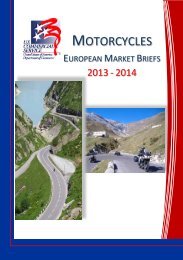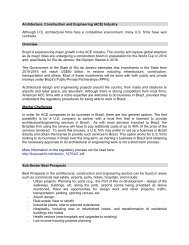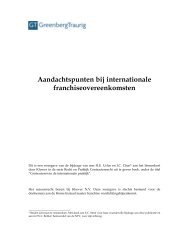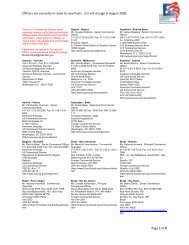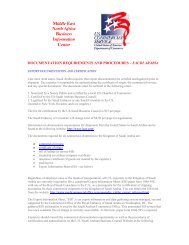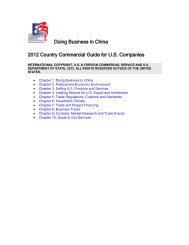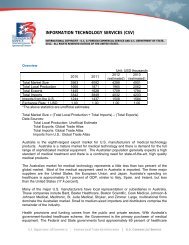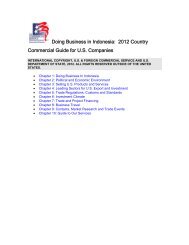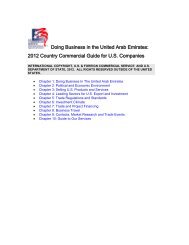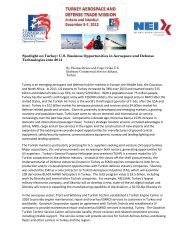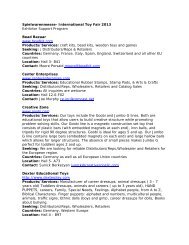Advantages & Applications of MBBR Technologies - Export.gov
Advantages & Applications of MBBR Technologies - Export.gov
Advantages & Applications of MBBR Technologies - Export.gov
You also want an ePaper? Increase the reach of your titles
YUMPU automatically turns print PDFs into web optimized ePapers that Google loves.
<strong>Advantages</strong> &<br />
<strong>Applications</strong> <strong>of</strong><br />
<strong>MBBR</strong><br />
<strong>Technologies</strong>
Wastewater <strong>Technologies</strong><br />
Attached Growth Suspended Growth<br />
Static Fixed film Dynamic Fixed Film<br />
•Trickling filters<br />
•Rope media<br />
•Web media<br />
•Biological active<br />
filters (BAF)<br />
•Rotating<br />
biological<br />
contactors (RBC)<br />
•Moving Bed<br />
Bi<strong>of</strong>ilm Reactors<br />
(<strong>MBBR</strong>)<br />
•Plastic seaweed<br />
type media<br />
Activated sludge<br />
Continuous treatment<br />
•Conventional<br />
Activated sludge<br />
•MLE nutrient<br />
removal<br />
•Barden pho<br />
process<br />
•Membrane Bioreactors<br />
(MBR)<br />
Integrated Fixed-Film Activated Sludge (IFAS)<br />
Batch Treatment<br />
•Sequencing batch<br />
reactors (SBR)<br />
•Membrane Bioreactors<br />
(MBR)
Usually to<br />
Landfill<br />
General Overview <strong>of</strong> Plant’s<br />
A<br />
Raw Wastewater Influent<br />
Preliminary Residuals<br />
(i.e., grit, rags, etc.)<br />
B<br />
Wastewater<br />
Treatment<br />
Residuals<br />
Biosolids<br />
Processing<br />
and Disposal<br />
Components<br />
Primary Sludge<br />
PRELIMINARY<br />
C<br />
Clarifier<br />
PRIMARY<br />
Biological<br />
Treatment<br />
System<br />
Secondary Sludge<br />
SECONDAR<br />
Y<br />
(e.g., attached-growth<br />
Suspended-Growth,<br />
Constructed Wetland, etc.)<br />
Clarifier<br />
TERTIARY<br />
Clean Wastewater Effluent<br />
Discharge to Receiving Waters
Fixed Film <strong>Technologies</strong><br />
Trickling filters are a<br />
static, air phase<br />
fixed film treatment<br />
system.<br />
RBCs are partially<br />
water and air phase.<br />
<strong>MBBR</strong>s are<br />
dynamic, water<br />
phase fixed film<br />
treatment systems
<strong>MBBR</strong> = Moving Bed Bi<strong>of</strong>ilm<br />
Reactor<br />
• Headworks Bio Inc’s process is based on<br />
the bi<strong>of</strong>ilm principle using polyethylene<br />
carrier elements.<br />
• The carrier elements, which are less<br />
dense than water,0.93-0.95 SG, provide a<br />
large protected surface for bacteria<br />
culture.<br />
• <strong>MBBR</strong> provides advantages <strong>of</strong> Activated<br />
Sludge and Trickling Filter systems<br />
without their disadvantages.<br />
• <strong>MBBR</strong> is one <strong>of</strong> the most documented<br />
processes with many technical<br />
publications and presentations.
Dynamic Water Phase Fixed<br />
• No problems with odors, snails or red-worms as in air phase fixed films.<br />
• Easier transfer <strong>of</strong> contaminants and oxygen to the biomass.<br />
• Bi<strong>of</strong>ilm thickness is maintained and controlled by continuous sloughing created<br />
by the aeration-mixing process.<br />
• NO attrition <strong>of</strong> media – plants 20 years old are still using original media<br />
Stagnant Liquor<br />
Films
Bi<strong>of</strong>ilm Growth on Media<br />
Mixing energy controls the biological thickness<br />
BOD<br />
Nitrifiers
More Than Just Plastic<br />
Successfu<br />
l<br />
Installatio<br />
ns<br />
Virgin<br />
HDPE<br />
15+ Years<br />
<strong>of</strong> R&D<br />
*<br />
Superior<br />
Media<br />
Compositi<br />
on<br />
Customiza<br />
ble<br />
Solutions<br />
Process<br />
Design<br />
Experts
Customizable Processes
What’s the Difference?<br />
IFAS<br />
Integrated Fixed Film Activated Sludge<br />
� Includes Return Activated<br />
Sludge (RAS)<br />
� Fixed film & Suspended<br />
growth<br />
Return Activated Sludge<br />
Waste Activated Sludge<br />
<strong>MBBR</strong><br />
Moving Bed Bi<strong>of</strong>ilm Reactor<br />
� No RAS - ““““Once through””””<br />
process<br />
� Fixed film Only<br />
Waste Sludge
• Self regulating biomass.<br />
• Flexible Design that allows for<br />
increased capacity.<br />
• No operational adjustments, only<br />
equipment maintenance.<br />
• Stable under large load variations.<br />
• Smaller foot prints.<br />
• Low investment Cost.<br />
• Single pass treatment.<br />
• Multiple applications.<br />
• Extremely compact and simple<br />
biological treatment system.<br />
Why <strong>MBBR</strong>?
Key <strong>MBBR</strong> Design Parameters<br />
• Organic surface loading rate (g BOD/m2d)<br />
Normal rate : 10 – 13 g BOD 5/m 2 d @25 o C<br />
• Protected surface area <strong>of</strong> carrier (m2/m3)<br />
400 – 680 m 2 /m 3 for Headworks ActiveCell<br />
Media<br />
• The Biomedia carrier filling fraction (%)<br />
Normally : 50 – 67 % (minimum 30%)<br />
• Temperature<br />
• k T = 1,07(T-10) (when T = 5 – 10 oC)<br />
• k T = 1,06(T-10) (when T = 10 - 20 oC)
Key Components: <strong>MBBR</strong><br />
Aeration Grid<br />
Retention Sieves<br />
Activecell Media<br />
1% = Equipment Supply / 99% = Knowledge
Features:<br />
• Single pass treatment<br />
• No operational adjustments<br />
• Only equipment maintenance<br />
• Self regulating biomass<br />
• Small foot print<br />
• Multiple applications<br />
<strong>Applications</strong><br />
BOD/COD<br />
Reduction<br />
Nitrification<br />
Denitrification
• High loads<br />
• Up to 6000 mg/l<br />
• Small foot print<br />
• Single pass treatment<br />
• No recycle<br />
• No operator adjustments<br />
• Biology self regulating<br />
• Low BOD effluent<br />
BOD / COD Removal<br />
• 50% to 80 % reduction in 30 minutes<br />
• < 10 mg/l BOD (after clarification)
Nitrification Only<br />
NH 3-N < 1 mg/L<br />
IFAS <strong>Applications</strong><br />
(works best at temperatures < 25° C)<br />
Existing Plant<br />
BOD & TSS = 30 mg/L<br />
Pre-DN & Nitrification<br />
NH 3-N < 1 mg/L &<br />
TN >8 mg/L<br />
D<br />
D<br />
Inf.<br />
Pre & Post DN<br />
NH 3-N < 1 mg/L &<br />
TN < 3 mg/L<br />
Internal Recycle<br />
D<br />
D<br />
D<br />
D<br />
COD<br />
Pre- BOD Reduction Nitrification<br />
Post<br />
D-nitrification<br />
D-nitrification<br />
Return Sludge<br />
Clarification<br />
Eff.<br />
Waste<br />
Sludge
Biological Phosphorous<br />
Removal<br />
• Decreases tank volume required for BOD/COD and Nitrification<br />
allowing room for Bio-P and De-nitrification.<br />
• Allows for the suspended growth sludge age to be tailored for<br />
maximum phosphorus removal.<br />
• Nitrification biology grows on media and is not affected by low<br />
sludge ages <strong>of</strong> suspended growth.<br />
D<br />
D
Footprint Comparison<br />
Tricking Filter vs. <strong>MBBR</strong><br />
EXISTING TRICKLING FILTERS<br />
99 m 2 /m 3<br />
VOL = 3990 m 3<br />
<strong>MBBR</strong><br />
548 m2/m3<br />
VOL = 720 m3<br />
AT EQUAL LEVELS OF BOD REMOVAL:<br />
<strong>MBBR</strong> Provides Five times the Bi<strong>of</strong>ilm Surface Area in less than<br />
¼ Reactor Volume as Trickling Filter<br />
Kinetics = <strong>MBBR</strong> is More Active & Efficient than Trickling Filter
Foot print, m 2<br />
4000<br />
3500<br />
3000<br />
2500<br />
2000<br />
1500<br />
1000<br />
500<br />
Footprint comparison<br />
0<br />
<strong>MBBR</strong>+DAF<br />
<strong>MBBR</strong> + CLARIFIER<br />
ASP + CLARIFIER
Example Plant with 5000 m3/d design flow:<br />
Influent: BOD: 600mg/l, COD: 1000 mg/l, TSS 600 mg/l<br />
Effluent: BOD: 50 mg/l, COD: 80 mg/l, TSS 60 mg/l<br />
RBC requires 800 m2 area<br />
and 93 kW for disk drives<br />
RBC vs <strong>MBBR</strong><br />
<strong>MBBR</strong> requires 195 m2 area<br />
and 93 kW for air blowers.<br />
The power on the <strong>MBBR</strong> can be varied based<br />
on the influent load where the RBC cannot.
<strong>MBBR</strong> Areas <strong>of</strong> Focus<br />
INDUSTRIAL MARINE MUNICIPAL
<strong>MBBR</strong> Size vs. Activated Sludge<br />
• Activated Sludge Extended Air process is designed for 12 to 24 hours hydraulic<br />
retention time (HRT).<br />
• The <strong>MBBR</strong> need only 2 to 3 HRT to achieve the same level <strong>of</strong> nitrification.<br />
• This is less than or equal to ¼ the tank volume.<br />
• Typical biomass levels in activated sludge plants is between 2500 mg/l to 3500 mg/l <strong>of</strong><br />
suspended solids.<br />
• Typical equivalent biomass in an <strong>MBBR</strong> is 6000 mg/l <strong>of</strong> attach growth.<br />
• This is 2 times more available treatment mass.<br />
Al Balad, Jeddah
Tertiary<br />
Treatment<br />
(Sandfilter)<br />
DAF<br />
(Clarifier)<br />
Screen<br />
40m Diameter, 9m high – 40 000m3/d
Current<br />
Design<br />
Option<br />
1<br />
Option<br />
2<br />
Option<br />
3<br />
*BOD / TSS / NH 3<br />
• Capacity: 25,000<br />
m 3 /d<br />
• Effluent Quality:<br />
?<br />
• Capacity<br />
Increases to<br />
45,000 m3 /d<br />
• Effluent Quality:<br />
10/10/3*<br />
• Capacity<br />
Increases to<br />
90,000 m3 /d<br />
• Effluent Quality:<br />
10/10/3*<br />
• Capacity<br />
Increases to<br />
45,000 m3 /d<br />
• Effluent Quality:<br />
10/10/3*<br />
Carousel Upgrade<br />
(Typical Saudi Arabian Wastewater Plant)<br />
NITRIFYING REACTOR<br />
EXISTING<br />
SURFACE<br />
AERATORS<br />
EXISTING RAS<br />
BOD REACTOR<br />
NEW BAFFLE WALL<br />
SURFACE AERATORS<br />
RETENTION SCREENS<br />
NEW SECTION OF WALL<br />
NEW EFFLUENT<br />
NEW WALL WITH<br />
RETENTION SCREENS<br />
EFFLUENT<br />
NITRIFYING REACTOR<br />
RETENTION SCREENS<br />
BOD REACTOR<br />
RECYCLED FLOW<br />
EXISTING EFFLUENT<br />
EXISTING EFFLUENT<br />
BOD REACTOR<br />
AERATION GRIDS<br />
NEW WALL<br />
EXISTING INFLUENT<br />
NEW RETENTION SCREEN<br />
AERATION GRIDS<br />
NEW INFLUENT<br />
AERATION GRIDS<br />
NEW INFLUENT<br />
EXISTING INFLUENT<br />
NEW ROUGHING REACTOR<br />
NEW WALL WITH<br />
RETENTION SCREENS
BOD REACTOR<br />
RETENTION SCREENS<br />
NEW SECTION OF WALL<br />
NEW EFFLUENT<br />
NITRIFYING REACTOR<br />
NEW BAFFLE WALL<br />
NITRIFYING REACTOR<br />
Option 1<br />
RETENTION SCREENS<br />
BOD REACTOR<br />
Option 2<br />
EXISTING EFFLUENT<br />
NEW RETENTION SCREEN<br />
AERATION GRIDS<br />
AERATION GRIDS<br />
NEW INFLUENT<br />
EXISTING INFLUENT<br />
EXISTING<br />
SURFACE<br />
AERATORS<br />
EXISTING RAS<br />
NEW WALL WITH<br />
RETENTION SCREENS<br />
EXISTING EFFLUENT<br />
BOD REACTOR<br />
AERATION GRIDS<br />
Option 3<br />
NEW WALL<br />
NEW INFLUENT<br />
NEW ROUGHING REACTOR<br />
NEW WALL WITH<br />
RETENTION SCREENS<br />
Options for Upgrading Carousel System<br />
1 2 3<br />
Increase in Treatment Capacity 2X 4X 2X<br />
% Media Fill 30% 60% 40%<br />
Number <strong>of</strong> Internal Walls Removed 2 3 None<br />
Number <strong>of</strong> New Internal Walls 1 Short 1 3 Short<br />
New Influent Location No Yes No<br />
New Effluent Location No Yes No<br />
% Retr<strong>of</strong>it Existing Tank with Diffused Aeration<br />
System 100% 100% 25%<br />
Remove Existing Surface Aerators Yes Yes No
Capacity Increase<br />
Flow increase <strong>of</strong> 4 x 250 m 3 /d up to 4 x 1000 m 3 /d
Phased increase in capacity<br />
Existing plant capacity can be<br />
increased by adding more media into<br />
50% fill<br />
Flow = 1000 m3/d<br />
BOD Load = 300 kg/d<br />
Fill fraction = 50 %<br />
the <strong>MBBR</strong> Tank<br />
Existing<br />
<strong>MBBR</strong> After<br />
70% fill<br />
Flow = 1400 m3/d<br />
BOD Load = 420 kg/d<br />
Fill fraction = 70 %
Moorhead, MN: 22,750 m 3 /day
Agnico Eagle LeRonde Mine: Cadillac,<br />
Quebec
Jamaica: 8,000 m 3 /day
Finland: 18,500 m 3 /day
RCCL Vision <strong>of</strong> the Seas<br />
RCCL Enchantment <strong>of</strong> the Seas<br />
Celebrity Constellation<br />
Marine Installations<br />
CleanSea® Shipboard Wastewater Treatment<br />
Celebrity Millennium<br />
RCCL Jewel <strong>of</strong> the Seas<br />
RCCL Brilliance <strong>of</strong> the Seas<br />
Celebrity Summit<br />
RCCL Radiance <strong>of</strong> the Seas<br />
RCCL Project Genesis
Onboard the Largest Cruise Ship in<br />
the World
Extensive Installation List<br />
Installations including municipal in the following<br />
industries:<br />
• Domestic/Resort<br />
• Food Processing<br />
• Landfill Leachate<br />
• Marine<br />
• Meat Processing<br />
• Mining<br />
• Petrochemical<br />
• Pharmaceuticals<br />
• Power Plant<br />
• Pulp & Paper<br />
• Septage Processing<br />
• Vehicle Wash
HIT System<br />
Headworks Integrated Treatment System<br />
Single Train with DAF<br />
DN-BOD-Nitrification, 500 – 650 m3/d, at 25 C
HIT System<br />
Headworks Integrated Treatment System<br />
Flow: (60 m3/day) Influent:<br />
300/300/40 Effluent: 10/10/2
Comparison: MBR vs <strong>MBBR</strong><br />
MBR Plant <strong>MBBR</strong> Plant<br />
Capital Investment High Low<br />
Footprint Low Low<br />
Flow Tolerance Low High<br />
Aeration Blowers Required Required<br />
Recirculation Pumps Required Not Required<br />
Air Scouring Blowers Required Not Required<br />
Screening<br />
Requirements<br />
High Low<br />
Chemical Usage High N/A<br />
Operational Difficulty High Low
<strong>MBBR</strong> RBC Activated Sludge SBR<br />
No residual<br />
suspended solids<br />
Self regulating, no<br />
operator adjustments<br />
Single pass flow<br />
through<br />
1 hour retention time<br />
(based on 800m3/d)<br />
8.25 m2 treatment<br />
area<br />
Not affected by high<br />
flows<br />
Low mechanical<br />
equipment<br />
Stable nutrient<br />
removal<br />
Comparison: 800 m 3 /day<br />
No residual suspended<br />
solids<br />
Self regulating, no<br />
operator adjustments<br />
Single pass flow<br />
through<br />
Requires residual<br />
suspended solids<br />
(MLSS)<br />
Operator adjusts MLSS<br />
levels<br />
MLSS sludge recycled<br />
back through plant<br />
4 hours retention time 4 hours retention time<br />
64 m2 treatment area 33.75 m2 treatment area<br />
Biology stripped <strong>of</strong><br />
media with high flows<br />
High mechanical<br />
equipment<br />
Unstable nutrient<br />
removal<br />
MLSS can be flushed<br />
out with high flows<br />
Moderate mechanical<br />
equipment<br />
Unstable nutrient<br />
removal<br />
Requires residual<br />
suspended solids<br />
(MLSS)<br />
Operator adjusts MLSS<br />
levels<br />
May or may not require<br />
MLSS recycle<br />
5 hours retention time<br />
(includes clarification)<br />
31.5 m2 treatment area<br />
(includes clarification)<br />
Rarely affected by high<br />
flows<br />
Low mechanical<br />
equipment<br />
Stable nutrient removal
Which Activecell media has<br />
the larger<br />
protected surface area?<br />
???
Questions?<br />
International<br />
Headquarters<br />
800 Wilcrest Dr, Suite<br />
340<br />
Houston, TX 77042<br />
hwbio@headworksusa.<br />
www.headworksbio.com<br />
com


